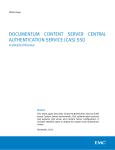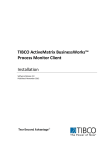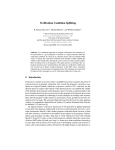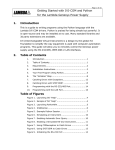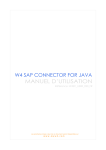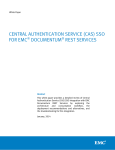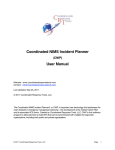Download The Hermes Framework User`s Manual
Transcript
The Hermes Framework User’s Manual
Éamonn Linehan, Mike Spence
hermes.dsg.cs.tcd.ie
2
The Hermes Framework User’s Manual
Version 1.0 (July 2007)
Copyright © Distributed Systems Group, Department of Computer Science, Trinity
College Dublin 2007. All rights reserved.
Comments may be addressed to:
Dr, Siobhán Clarke
Distributed Systems Group,
Department of Computer Science,
Trinity College,
Dublin 2.
Permission is granted to copy, distribute and/or modify this document under the terms
of the GNU Free Documentation License, Version 1.2 or any later version published
by the Free Software Foundation; with no Invariant Sections, no Front-Cover Texts,
and no Back-Cover Texts. A copy of the license available for download from
http://hermes.dsg.cs.tcd.ie/.
All code listings in this document are part of the Hermes Framework for the
development of Mobile Context-aware Trails-based Applications. The Hermes
Framework is free software; you can redistribute it and/or modify it under the terms
of the GNU Lesser General Public License as published by the Free Software
Foundation; version 3 of the License.
The Hermes Framework is distributed in the hope that it will be useful, but
WITHOUT ANY WARRANTY; without even the implied warranty of
MERCHANTABILITY or FITNESS FOR A PARTICULAR PURPOSE. See the
GNU General Public License for more details. A copy of the GNU Lesser General
Public License is distributed with the Hermes Framework. It can be found in a file
named COPYING.txt. If not, see <http://www.gnu.org/licenses/>.
3
Contents
1
PACKAGE CONTENTS ...........................................................................6
1.1
GISlite Library .........................................................................................................................7
1.1.1
Introduction ...........................................................................................................................7
1.1.2
Features .................................................................................................................................8
1.2
Hermes Framework .................................................................................................................9
1.2.1
Introduction ...........................................................................................................................9
1.2.2
Architecture ...........................................................................................................................9
1.3
Example Applications ............................................................................................................11
1.3.1
Where Am I ? ......................................................................................................................11
1.3.2
Where Are We ? ..................................................................................................................11
1.3.3
RiddleHunt ..........................................................................................................................12
2
DEVELOPMENT ENVIRONMENT .........................................................12
2.1
Hardware ................................................................................................................................12
2.2
Platform ..................................................................................................................................12
2.3
IDE ..........................................................................................................................................13
2.4
Compiling................................................................................................................................13
2.4.1
External Package dependencies...........................................................................................13
2.4.2
Internal Package Dependencies ...........................................................................................14
3
BUILDING APPLICATIONS WITH HERMES ........................................15
3.1
Configuring Hermes...............................................................................................................15
3.1.1
Properties file ......................................................................................................................15
3.1.2
Initialising............................................................................................................................16
3.1.3
Logging ...............................................................................................................................16
3.2
Configuring GISlite................................................................................................................17
3.2.1
Properties file ......................................................................................................................17
3.2.2
Data Sources........................................................................................................................19
3.3
Adding New Types of Context...............................................................................................19
3.4
Creating new Context Sources ..............................................................................................21
3.5
Connecting Context Sources .................................................................................................22
3.6
Defining new types of Messages ............................................................................................22
3.6.1
Application-specific CommunicationMessages .........................................................23
3.6.2
Superclass for the application-specific CommunicationMessages .............................23
3.6.3
Subclass the CommunicationMessageFactory ....................................................................23
3.6.4
Pass the subclass of the CommunicationMessageFactory into Hermes.init()......................24
3.7
Using Application Specific Context Capsules ......................................................................24
3.7.1
Creating Context Capsules ..................................................................................................25
3.7.2
Add those ContextCapsules to the ContextCapsuleManager ..............................................26
4
3.7.3
3.7.4
Create any application-specific Content classes..................................................................26
Start the ContextCapsuleThread..........................................................................................27
3.8
Using Application specific Context Queries.........................................................................27
3.9
Creating an interface for your application ..........................................................................28
3.10
Initialising your application ..................................................................................................29
3.10.1
Call init() methods of Hermes and GISlite .....................................................................29
3.10.2
Privacy settings...............................................................................................................29
3.10.3
Setting up the Interface...................................................................................................29
3.10.4
Registering for updates in Context .................................................................................30
3.10.5
Linking other ContextChangedEventListeners to the ContextManager .........................30
3.10.6
Adding ContextSources ..................................................................................................31
3.10.7
Registering to receive ApplicationMessages ..................................................................31
3.10.8
Creating new instance of the ContextCapsuleManager (if necessary)............................31
3.10.9
Starting the ContextCapsuleThread (if necessary)..........................................................32
4
RELATED DOCUMENTS.......................................................................33
5
APPENDIX .............................................................................................35
5.1
Code Listing............................................................................................................................35
5.2
List of Figures.........................................................................................................................35
5
1 Package Contents
This section describes the contents of this package and the directory structures within
the Hermes framework distribution.
Package
1. GISlite Library
2. Hermes Framework
3. Examples
a) Where Am I?
b) Where Are We?
c) RiddleHunt
Figure 1 - Distribution Contents
1. The GISlite project is a standalone library for accessing, manipulating and
displaying spatial data. This library is used by the example applications to provide
an interface to display contextual information. This project contains the following
sub directories;
• \bin – The compiled java code
• \dist – A packaged .jar or .jxe file containing all the compiled code and
resources from the \bin directory
• \src – the source code
• \doc – Javadoc API documentation
2. The Hermes project contains the framework itself. The directory structure within
the project is the same as for the GISlite project;
• \bin – The compiled java code
• \dist – A packaged jar / jxe file containing all the compiled code and
resources from the \bin directory
• \src – the source code
• \doc – Javadoc API documentation
3. The Examples directory contains three example applications;
• Where Am I? – Demonstrates the Hermes framework being used to gather
‘location’ context from a GPS context source and the GISlite project being
used to display this information on a map.
• Where Are We? – Extends the WhereAmI application to add a
demonstration of the Hermes frameworks ability to share context between
6
•
devices. In this case the map display shows where neighbouring users are
on the screen.
RiddleHunt – A treasure hunt game involving the solving of riddles built
using the Hermes framework.
Note: RiddleHunt code included here is incomplete. It is provided as an example of
using the framework and is not a playable version of the game.
The following sections will introduce and describe the major features of each of the
packaged libraries.
1.1 GISlite Library
GISlite is a helper library for Hermes that facilitates the generation of a map-based
spatial context visualisation at different resolutions and levels of detail for mobile
users.
1.1.1 Introduction
The GISlite library is designed to facilitate the rendering and reasoning over vector
map data on mobile devices. The library is designed to be very simple to use and
features an intuitive API. The API makes it easy to add additional layers to the map
and to manipulate the map. For example map layers can be added to illustrate
contextual information or custom controllers can be written to orientate and scale the
map based on the user’s location. GISlite also supports spatial reasoning and route
generation. The following diagram illustrates the level at which the GISlite library is
integrated into the component view of the Hermes framework.
7
RENDER
INDEX
ORIENTATE
PROJECTION
Spatial Model
Figure 2 - How GISlite works with Hermes
1.1.2 Features
•
•
•
•
•
•
•
•
•
•
Equirectangular and Cylindrical cartographic coordinate system projections.
Vector data rendering and retrieval from ESRI Shapefiles1.
Multi-resolution spatial visualisation featuring scale sensitive level of detail
and line simplification.
Online continuous generalisation via nth algorithm for simple features (coast,
lakes, rivers etc) and a variation of the Douglas-Peuker algorithm for complex
features.
Track-up orientated spatial visualisation.
Rectangular polygon and line clipping to reduce the number of points to be
drawn and further speed up rendering (Wriler-Atherton, SutherlandHodgeman and Liang-Barsky algorithms implemented).
Shortest path topographical route generation.
Quad-tree region based spatial indexing.
Support’s zoom, pan and rotate operations.
Support for spatial operations such as containment, intersection, union, and
distance on all features.
1
ESRI Shapefiles store nontopological geometry and attribute information for spatial
features. The geometry for a feature is stored as a shape comprising a set of vector
coordinates. Shapefiles support point, line, and area features. Attributes are held in a
dBASE® format file. Each attribute record has a one-to-one relationship with the
associated shape record.
8
1.2 Hermes Framework
1.2.1 Introduction
Hermes is a software framework for mobile, context-aware trails-based applications
which will support developers by providing generic components containing structure
and behaviour common to all trails-based applications. At the most general level, a
trail can be thought of as a collection of activities with associated locations, and a
dynamically reconfigurable recommended visiting order. The trail is a collection of
connected locations rather than a strict sequence since it may contain alternative subroutes to cater for such variables as different modes of transport or user preferences.
Trails underpin a wide range of useful applications for a mobile user who has a set of
activities that may or should be carried out throughout the day at different locations.
Combining the trails concept with mobile, context-aware technology creates
opportunities for innovative activity-based application development. Mobile, contextaware applications are those that run on wireless devices e.g., PDAs and smartphones,
and have an awareness of the physical and social situation in which they are deployed.
Examples of trails applications that are both mobile and context-aware include tour
guides, courier support/management systems, basic route planners, treasure hunt
games and student support systems.
The following section will give an overview of the architecture of the framework.
1.2.2 Architecture
Applications
GIS
Trails
Context Management
Modeling
Context Container
Context
History
Collaboration
inbound
outbound
Trust
Privacy
Acquisition
Sharing
Communication
Service
Discovery
Figure 3 - Hermes framework component architecture.
9
Figure 3 - Hermes framework component architecture. shows a component level view
of the of the Hermes framework. The diagram describes a layered software
framework in which each layer is self contained and is isolated from the effects of
changes in other layers through a combination of interfaces, event based call backs
and message passing.
The architecture diagram should be read from a ‘bottom-up’ perspective as each
ascending layer in the architecture builds upon the functionality of lower layers. At
the bottom layer of the architecture is the communication component. It is the
responsibility of this layer to manage the communication with sensors, infrastructure
and peer devices over a variety of networks. This layer also manages bandwidth and
the discovery of other devices supporting the Hermes framework.
Above communication are the components that support collaboration in the Hermes
framework. They are seperated into columns to illustrate the separation between the
inbound and outbound aspects of collaboration. On the inbound side (left) are the
acquisition and trust components. The acquisition component is responsible for
proactively seeking out and acquiring specific types of context on behalf of an
application. The trust component works with acquisition to augment incoming
messages with trust related metadata. On the outbound side of the collaboration
components are the sharing and privacy components. The sharing component is
responsible for responding to incoming requests for context and the privacy
component provides for the protection of personal data by limiting which types of
context are exchanged with which peers.
Above the collaboration layer is the context management layer containing the context
container and modelling component. The modelling component handles the fusion of
context and the conversion of incoming context to the context manager’s internal
representation. In addition to the modelling component there is a context container
that is responsible for storing context persistently. The context container can hold
context in memory or persist it to disk in response to the freshness of the context and
the memory available on the device. The context container makes its context available
by providing an interface for context queries and also making it possible for
applications to register to be notified if a particular context changes.
It is at this level that many other context-aware toolkits end their support for
application developers. In contrast Hermes contributes two additional closely
collaborating components that provide solutions for a number of technical challenges
common to trails-based applications. Theses components are the trails component and
GIS component. The trails component is responsible for the generation and
management of trails. The GIS component is responsible for maintaining a model of
the structure and geography of the user’s environment for the purpose of supporting
more intelligent reasoning by the trails component and improving the overall user
experience of trails-based applications.
10
1.3 Example Applications
A number of example applications are included in the package. We list them here in
order of complexity.
1.3.1 Where Am I ?
This is the first example application. It is very small (only two classes) and is intended
to demonstrate the integration of GISlite and Hermes libraries by the addition of a
map layer that overlays contextual information gathered by the Hermes framework
over a GISlite map rendering.
Figure 4 –Where Am I ? Interface
1.3.2 Where Are We ?
The second example builds on the first example. In this application in addition of
producing a map layer showing a single piece of contextual information, a map layer
showing the locations of all other people discovered by the Hermes framework on the
map interface.
11
1.3.3 RiddleHunt
Figure 5 - Riddle Hunt
Riddle Hunt is a multiplayer, riddle solving game in which the application assists
users in playing the game by both presenting context information such as other
players’ locations and by generating trails designed to help the player win the game.
The version of the game included in this package is not the full version but is
provided as a illustration of how to expand the capabilities of the framework
components to handle extensions such as previously undefined types of context and
new sensors.
2 Development Environment
This section provides the information necessary to build the source in this package.
2.1 Hardware
All the software in this package was designed to run on a PDA like device supporting
a Java VM. The software has been successfully tested during development on HP
IPAQ (h6300) devices running Windows Mobile 2003 and IBM Workplace Client
Technology, Micro Edition JVM.
2.2 Platform
The Hermes framework is written in Java but is designed for the J9 Java VM. The J9
VM is an implementation of the Java Virtual Machine Specification, Version 1.3.
J9 VM can be downloaded as part of IBM Workplace Client Technology, Micro
Edition 5.7 from the IBM website (requires registration). Included in this download is
J9 (a.k.a IBM WebSphere Everyplace Micro Environment).
The following diagram illustrates the platform on which Hermes is designed to run.
12
Trails Based Applications
GISlite & Hermes
JXE Native Compilation & Optimisation
Personal Profile
Personal Basis Profile
Foundation Profile
Connected Device Configuration (CDC)
J2ME
IBM Websphere Everyplace Micro Environment (WEME)
Pocket PC
ARM / XScale based processor
Figure 6 - Hermes Platform
2.3 IDE
All the code in this package was developed using WebSphere Studio Device
Developer. Device Developer is an integrated development environment for the
creation and testing of applications that will be deployed on handsets and other small
devices.
2.4 Compiling
To compile all the source included in this distribution it is necessary to be aware of
the compilation dependencies for each of the projects.
2.4.1 External Package dependencies
For each of the projects there are a number of external libraries which are required to
compile and run the code. The table below lists these dependencies. In all instances
the dependant libraries are included in the distribution and can be found in the /lib
directory of the appropriate project.
13
Project
GISlite
Hermes
Jar
n/a
db4o-6.1-java1.1.jar
kxml-min.jar
RXTXcomm.jar
Detail
n/a
Object database engine.
Very small memory footprint
XmlPull Parser optimized for
J2ME
Provides access to serial ports
in Java.
Table 1 – External Package dependencies
2.4.2 Internal Package Dependencies
The projects themselves are dependant on each other. In order to compile Hermes you
will need to have GISlite on the build path. In order to compile any of the examples
you will need both GISlite and Hermes on the build path.
GISlite
Examples
Hermes
Figure 7 - Compilation dependencies
14
3 Building applications with Hermes
This section covers all the tasks necessary to build a context-aware trails-based
application using a combination of GISlite and the Hermes framework.
3.1 Configuring Hermes
Many of the frameworks components are configurable in order to support different
hardware platforms. This section covers everything needed to configure the
framework for use by an application.
3.1.1 Properties file
A properties file is used to store all the configuration settings for the framework
components. The framework requires this properties file to run and looks for it in the
current working directory /config/hermes.properties. The properties file
itself is a list of key value pairs. Each pair is on a separate line and lines beginning
with # are comments.
# Hermes Properties File. DO NOT EDIT
# Communication properties
hermes.comms.threads.incoming=2
hermes.comms.samemachine=false
hermes.comms.heartbeattimeout=30000
hermes.comms.broadcast.port=4446
hermes.comms.broadcast.sleepinterval=10000
hermes.comms.listening.timeout=10000
hermes.comms.listening.sleep=5000
hermes.comms.receive.timeout=5000
hermes.comms.receive.sleep=5000
hermes.comms.incoming.sleep=2000
# The Serial Comms API to use (J2ME / PC / Linux)
hermes.comms.serial.provider=J5SerialConnection
#hermes.comms.serial.provider=J2MESerialConnection
# The Context Container to use
hermes.context.container.provider=DB4OContextContainer
#hermes.context.container.provider=InMemoryContextContainer
# Context Data Store
hermes.context.container.objectcontainer.file=data/db4o
#hermes.context.container.objectcontainer.file=Storage
Card/Hermes/data/db4o
# GPS (PC)
hermes.comms.gps.comm=4
hermes.comms.gps.baud=9600
# GPS (IPAQ)
# hermes.comms.gps.comm=7
# hermes.comms.gps.baud=9600
# Context Capsule properties
hermes.context.capsules.capsulesleeptime=5000
15
# Trail Generation
hermes.trail.subtrail.size=5
hermes.trail.reconfiguration.interval=10000
# the trail reconfiguration strategy
hermes.trail.reconfiguration.strategy=brute
#hermes.trail.reconfiguration.strategy=genetic
#hermes.trail.reconfiguration.strategy=annealing
hermes.trail.reconfiguration.relevence.threshold=0.8
# Debugging
hermes.debug.log.sysout=true
hermes.debug.log.file=data/hermes.log
#hermes.debug.log.file=Storage Card/Hermes/data/hermes.log
Listing 1 – Sample Hermes Properties File Contents
3.1.2 Initialising
The Hermes framework includes a static class that is used to initialise all the
framework components, integrate these components where necessary and provide a
single point of access to the framework for your application. To initialise the
framework in your application the following statement should be executed.
Hermes.init(_appKey);
Listing 2 – Hermes Initialisation
The _appKey parameter uniquely identifies the application initializing the
framework. This is used to distinguish among multiple applications accessing the
framework in the case (while debugging) that multiple framework instances reside
within the same JVM. For a specific application this string can be assigned to
anything.
3.1.3 Logging
The Hermes framework includes a configurable logging utility that an application can
call to print or record debugging information. To log information a statement similar
to the following should be added.
Hermes.log.info("Hermes Framework (c) DSG 2007", Hermes.class);
Listing 3 - Logging
There are also Hermes.log.debug and Hermes.log.error methods. The methods
take two parameters. The text to log and the class (if static) or object that the message
is coming from. An example of how the Hermes logger may format this example
would be.
INFO 01.08.2007 2:45:15 [Hermes] Hermes Framework (c) DSG
2007 (main)
16
The reason the class name is required is that the logging can be filtered by class. This
is important because the volume of debugging information may be significant. For
example it may be desirable to see all the debugging messages from just a single
class. To allow for such configuration there is a properties file included as a resource
in the build of Hermes that specifies which classes should export debugging
information, which level of debugging is required (info, debug or error) and also
whether to dump the logging information to the default output stream or write it to a
file. An example of the default settings for this file is the following:
# RHLog Properties file. DO NOT EDIT
#
#
#
#
#
#
#
#
#
#
#
#
#
#
Example:
To Log from every class
ie.tcd.cs.dsg.hermes.*=true
To Log from every class except riddle hunt
ie.tcd.cs.dsg.hermes.*=true
ie.tcd.cs.dsg.hermes.app.RiddleHunt=true
To log from only RiddleHunt class
ie.tcd.cs.dsg.hermes.*=false
ie.tcd.cs.dsg.hermes.app.RiddleHunt=true
NOTE: Omitting a class name is equivalent to setting it to false
# PER CLASS LOGGING SETTINGS FOLLOW
ie.tcd.cs.dsg.hermes.*=true
ie.tcd.cs.dsg.hermes.comms.MessageInputStream=false
# END
Listing 4 – Default Logging Properties File
3.2 Configuring GISlite
This section covers the configuration of the GISlite library so that it may be used
alongside Hermes to produce an interface to a trails-based application.
3.2.1 Properties file
GISlite requires its own properties file which must be placed in the path
/gislite/gislite.properties from the current working directory. This file
specifies the configuration options of the algorithms that are included in this library as
well as specifying the data sources from which to retrieve spatial data. These data
sources must be ESRI Shapefiles.
# GISlite Properties File.
# Debugging
gislite.debug=true
# Screen Size
gislite.screen.width=240
gislite.screen.height=300
17
# Initial Scale
gislite.scale=2760.3848
gislite.scale.cache.factor=2.5
# Initial Center of Map
gislite.center.lat=53.341442
gislite.center.lon=-6.2501383
# Data Sources
gislite.source.count=3
gislite.source.buffer=1024
gislite.source.3.type=shp
gislite.source.3.file=shapefiles\\country.shp
gislite.source.2.type=shp
gislite.source.2.file= shapefiles\\building_outlines.shp
gislite.source.1.type=shp
gislite.source.1.file=shapefiles\\text.shp
# Projection (EQUIRECTANGULAR)
gislite.projection=EquiRectangular
#gislite.projection=Orthographic
#gislite.projection=Lambert
#gislite.projection=Mercator
# Parametric Line & Polygon Clipping Algorithms
gislite.projection.clip.line=CohenSutherland
#gislite.projection.clip.line=LiangBarsky
gislite.projection.clip.poly=SutherlandHodgman
#gislite.projection.clip.poly=WeilerAtherton
#gislite.projection.clip.poly=Maillot
gislite.projection.clip.points.threshold=150
gislite.projection.clip.area.multiple=3
# Generalisation
gislite.geometry.filter.lod=MinimumAreaFilter
gislite.geometry.filter.lod.tolerance=20
# Geometry Simplification
gislite.geometry.generalise.tolerance=3
gislite.geometry.generalise.threshold=6000
# R-Tree Spatial Indexing
# > 40 * max node entries + 9
index.spatial.storage.pagesize=512
index.spatial.rtree.maxnodecapacity=12
index.spatial.rtree.minnodecapacity=5
index.spatial.rtree.nodesplit=Quadratic
#index.spatial.rtree.nodesplit=Linear
index.spatial.cache.size=8
Listing 5 – Sample GISlite Properties File
18
3.2.2 Data Sources
The data sources referred to in the above properties file must match the path to a
‘.shp’ ESRI Shapefile. Examples of such files can be found in
gislite/shapefiles/. A ‘.dbf’ attribute record file is required for each
shapefile but all other files in this directory will be generated if missing by GISlite.
The following table lists the file extensions that may be found in this directory and the
purpose of the files.
Note: As GISlite will generate files while running and place them in this folder, it
must be writeable.
Extension
Description
SHP
Shapefile containing geometry. Multiple shapefiles may appear with
similar names in this directory. These are multi-resolution caches of
the original SHP file and can be safely removed at any time.
dBase Attribute database.
Shape Index – Flat index providing faster access to large SHP files.
Spatial Index – Flat index providing minimum bounding rectangle
based access to SHP file records.
A Quad-tree spatial index.
DBF
SHX
SSX
QIX
Table 2 - Data source file extensions.
3.3 Adding New Types of Context
To demonstrate adding new types of Context to an application, we will use examples
from RiddleHunt’s application-specific Contexts: Game and Player. Game extends
the abstract Context, Artefact and Player extends the concrete Context, Person.
Several methods need to be overridden.
o A protected constructor without arguments. The constructor is protected because
all Context should be created with the following ContextFactory method:
public Context createNewContext(String type)
Listing 6 – The signature of the ContextFactory method for creating Context
o All outside access to a Context object should be done through setter methods.
This is particularly important, as the Context objects must keep track of when they
were last updated in order to aid in recognizing stale Context, among other
considerations. This timestamp maintenance is carried out by the inclusion of an
updateTimestamp() call in all the setters. An example from Player follows:
public void setScore(int i) {
updateTimestamp();
_score = i;
}
Listing 7 – An example of a setter that calls updateTimestamp()
As a consequence of having the updateTimestamp() call in the setters, it
must be disabled when using the setters and the timestamp should not be updated.
This is done by setting the Context attribute _shouldSetTimestamp to false at the
19
beginning of those methods and setting it back to true after all the setters have
been called. This should be done for any methods that want to set the attributes of
the Context but do not wish to update the timestamp, e.g., the clone, merge, and
fromXML methods all with to populate a Context object’s attributes but do not
wish to update the timestamp. For an example see the clone and merge discussion
below.
o A clone method must be implemented if a deep copy of any structure is required.
The clone() method from the Trail Context is shown below. A deep copy of the
Trail’s Activity array and Activity HashMap is required. Notice the
_shouldSetTimestamp statements described above surrounding the setter:
public Object clone() {
Trail clonedTrail = (Trail) super.clone();
clonedTrail._shouldSetTimestamp = false;
// A deep copy of the Activity array and the Activity map
Activity[] clonedActivities = null;
if (activities != null)
{
clonedActivities = (Activity[]) activities.clone();
}
clonedTrail.setActivities(clonedActivities);
clonedTrail._shouldSetTimestamp = true;
return clonedTrail;
}
Listing 8 – An example of the clone() method for the Trail context
o toXML() and fromXML() for converting Context to and from XML for use in
CommunicationMessages. As mentioned above, fromXML() needs turn off any
timestamp update if it uses a setter.
o merge() also needs to dictate what behavior to execute when merging two
Contexts of the same type. E.g., a common merging strategy is to populate the
Context with the values of whatever Context has the most recent timestamp. As
mentioned above, merge() should turn off any timestamp update if it uses a
setter.
public boolean merge(Context c) {
boolean changed = false;
if (c instanceof Player) {
Player player = (Player) c;
_shouldSetTimestamp = false;
// If the above was merged that means,
// there should be some new data
if (super.merge(player))
{
this.setScore(player.getScore());
this.setStrategy(player.getStrategy());
this.setIsGamesMaster(player.isGamesMaster());
changed = true;
}
20
_shouldSetTimestamp = true;
}
return changed;
}
Listing 9 – An example merge() method for subclasses of Context
Adding new types of Context requires an extension of a few classes beyond the actual
Context classes.
o ContextType should be extended to store the static Strings representing the
new context types. In RiddleHunt, the class extending ContextType is
RHContextType and contains the Strings:
public static final String GAME = "Game";
public static final String PLAYER = "Player";
Listing 10 – Context type String attributes of RHContextType
o In addition, ContextFactory should be extended to add the new Context
types to the list of Context currently available and allows the new types to be
created via the ContextFactory. This is done by adding the new types to the
ContextFactory data structures via the addNewContextType() call. The
first argument is the Context type’s String, the second is a prototype for creating
new Context objects, and the last designates this context type as abstract or not.
In RiddleHunt, the RHContextFactory has these calls in its constructor to add
the Game and Player types:
// Add any types that are not added by the super classes
addNewContextType(RHContextType.GAME, new Game(), false);
addNewContextType(RHContextType.PLAYER, new Player(), false);
Listing 11 – Calls made in RHContextFactory constructor to add new types of Context
o Finally, if any of the new types require a special ContextQuery to retrieve
context, this needs to be created by extending the ContextQueryFactory, as
described in Section 3.8.
3.4 Creating new Context Sources
The framework is designed so that new context types and context sources can be
easily added. It is a simple process to implement the code to support a new type of
context source. Context sources can be anything from a new type of sensor to an
online service.
Hermes contains a GPS context source ready to use and this code serves as an
example of how to create your own context sources:
public class GPSReceiver extends ContextSource {
/** The ContextTypes that GPS receivers can deliver */
private static final String [] _gpsContextTypes =
21
{ ContextType.LOCATION};
private static final ContextServiceDescription[]
_contextServiceDescriptions =
ContextServiceDescription.getDescriptionsFromType(_gpsContextTypes,
true);
public GPSReceiver(SerialAddress serialPortAddress) {
// Setting the last time this was updated to
// be MIN_VALUE, so it will always get updated
super(new Device("GPS Receiver", serialPortAddress),
_contextServiceDescriptions, System.currentTimeMillis(), 5000);
}
}
Listing 12 – Creating a ContextSource
The important aspects of this code listing is that every context source must have a
reference to an underlying instance of Device, a set of service descriptions and a
period to control the polling of the device. The service descriptions define the types of
context available from this device (in this case just location) and their format. This
information is used by the framework to determine how to format and model the
information as context.
3.5 Connecting Context Sources
Once the decision of which context sources should be available to the application is
made and the code extending the generic ContextSource class for each one is
written, it is necessary to inform the framework that at runtime it should connect to
the context source and acquire its context. This is facilitated by a single call to the
static Hermes class.
SerialAddress serialPort = new SerialAddress(
(short) commPort, baudRate);
GPSReceiver gps = new GPSReceiver(serialPort);
ContextServiceDescription[] sd =
(ContextServiceDescription[]) gps.getContextServiceDescriptions();
// Discover the context Source
Hermes.getCommunication().getServiceDiscovery().updateContextSourceLi
st(gps);
Listing 13 – Adding a Context Source to the application
3.6 Defining new types of Messages
If new types of CommunicationMessage are needed, four steps need to be
carried out:
1. Create the application-specific CommunicationMessage
2. Create a superclass for the application-specific CommunicationMessage
3. Create a subclass of the CommunicationMessageFactory
4. Pass the subclass of the CommunicationMessageFactory into
Hermes.init().
22
3.6.1 Application-specific CommunicationMessages
A subclass of CommunicationMessage needs to be created for every new
concrete type of message an application requires. These need to override the
messageHelper() method that converts its data to XML and contain a
createXXXMessage() method that creates a new message from XML, where
“XXX” stands for the specific type of message. In RiddleHunt, the only new message
is the StartGameApplicationMessage that extends
RHApplicationMessage (see below). This class overrides
messageHelper() and contains the method
createStartGameApplicationMessage().
3.6.2 Superclass for the application-specific
CommunicationMessages
•
If the new CommunicationMessage is a subclass of ServiceMessage,
ContextMessage, or ApplicationMessage, that superclass itself must be
extended. These new subclasses direct the messages of the newly created types to
their corresponding classes with their corresponding createXXXMessage()
methods. In RiddleHunt, the ApplicationMessage is extended by
RHApplicationMessage, which directs any
StartGameApplicationMessages to the correct method:
public static RHApplicationMessage
createApplicationMessage(XMLElement element) {
RHApplicationMessage retMessage = null;
String messageTypeString =
element.getAttributeValue("messageType");
if (messageTypeString != null) {
int messageType;
try {
messageType = new
Integer(messageTypeString).intValue();
} catch (NumberFormatException nfe) {
messageType = UNKNOWN_MESSAGE_TYPE;
}
if (messageType == START_GAME_TYPE) {
retMessage = StartGameApplicationMessage
.createStartGameApplicationMessage(element);
} else {
Hermes.log.error(
"createApplicationMessage: Unknown Message Type = "
+ messageType,
RHApplicationMessage.class);
}
}
return retMessage;
}
Listing 14 – Directing the input XML to the correct RHApplicationCommunicationMessage class
3.6.3 Subclass the CommunicationMessageFactory
The application must provide a method for the framework to create an applicationspecific method if it receives one. To do this, the
23
CommunicationMessageFactory must be extended and the
createSpecificMessage() method must be overridden. This method handles
the creation of any of the application-specific messages by calling the correct
createXXXMessage() method. This will be a static method of a specific
concrete CommunicationMessage or an extension of an existing abstract
superclass (e.g., in RiddleHunt, RHApplicationMessage extends the abstract
ApplicationMessage). If the type of message passed in is not a newly created
type, the input is passed on to the createSpecificMessage() method of the
superclass. In RiddleHunt, RHCommunicationMessageFactory extends
CommunicationMessageFactory which contains the overridden
createSpecificMessage() method. In this case, the only application-specific
CommunicationMessage is an RHApplicationMessage. The other
CommunicationMessages are passed on to the superclass
(CommunicationMessageFactory):
public CommunicationMessage createSpecificMessage(
int messageClass, XMLElement element) {
CommunicationMessage retMessage = null;
if (messageClass ==
CommunicationMessage.APPLICATION_MESSAGE_CLASS) {
retMessage =
RHApplicationMessage.createApplicationMessage(element);
} else {
retMessage = super.createSpecificMessage(
messageClass, element);
}
return retMessage;
}
Listing 15 – Subclass of CommunicationMessageFactory
3.6.4 Pass the subclass of the CommunicationMessageFactory
into Hermes.init()
Finally, a new instance of the subclass of CommunicationMessageFactory
must then be passed as a parameter to the init() method of Hermes in order to
assign it as the CommunicationMessageFactory for the application.
3.7 Using Application Specific Context Capsules
Much like a time capsule gives a clearer picture of the time period at which it was
created, a context capsule stores content, along with Surrounding Context Information
(SCI) that allows the application to interpret that content in its original context. This
content can be anything an application can interpret, such as a behavior or a piece of
context. Context capsules allow an application to activate its content when its SCI is
sufficiently similar to the device’s current context, e.g., if the context capsule’s
location in its SCI is similar to the device’s current location. For more information on
24
context capsules please refer to the paper "Preserving Context with Context Capsules"
listed in the Related Documents section of this document.
In the Hermes framework, the ContextManager periodically compares the
device’s current context to the SCI of each ContextCapsule. If the contexts are
similar, the ContextCapsule’s Content is activated. The Content can be a
piece of context such as an Activity or a Trail (ContextContent.class)
or a behavior such as turning on a light or presenting a collection of riddles
(BehaviorContent.class).
To use context capsules in a new application, four tasks need to be carried out:
1. Create any ContextCapsules necessary for the application.
2. Add those ContextCapsules to the ContextCapsuleManager’s
ContextCapsule collection
3. Create any application-specific Content classes.
4. Start the ContextCapsuleThread
3.7.1 Creating Context Capsules
The RiddleHunt code below creates ContextCapsules that let the application know
that riddles associated with a Location are available to be attempted when the
player’s location intersects the capsule’s location. The activated content is an
application-specific BehaviorContent, RHBehaviorContent with behavior
type RHBehaviorContent.RIDDLE_LOCATION_ACTIVATED_TYPE, that is described
later in this section.
// Set up geometry that if a Location is within the Geometry
// the capsule can be activated
Location bBox = (Location)
Hermes.getContextFactory().createNewContext(RHContextType.LOCATION);
bBox.setLocationGeometry(
new BoundingBox(location.getLocationAsPoint(),
RIDDLE_SQUARE_SIDE_LENGTH, RIDDLE_SQUARE_SIDE_LENGTH));
// Create the Content which is a RiddleLocationActivated
BehaviorContent bContent =
new BehaviorContent(new Object[] { location },
RHBehaviorContent.RIDDLE_LOCATION_ACTIVATED_TYPE);
// Create and add the capsule to the CapsuleStaging and location to
context capsule map
ContextCapsule capsule =
new ContextCapsule(
new Content[] { bContent },
new Context[] { bBox },
Communication.getLocalAddress(),
TIME_UNTIL_REACTIVATION);
_locationToContextCapsules.put(location, capsule);
addContextCapsule(capsule);
Listing 16 – Creation of ContextCapsules for the Riddles (From RiddleManager’s constructor)
25
As another example of a context capsule, the following code from RiddleHunt creates
an “end of game” capsule that notifies the application that the game should end. The
capsule is available to be activated when the current time is equal to or later than the
time in the capsule. The activated content is an application-specific
BehaviorContent, RHBehaviorContent with behavior type
RHBehaviorContent.END_GAME_TYPE, that is described below.
// Now add the EndGame capsule
_gameDurationInMinutes = Hermes.getProperties().getPropertyAsInt(
"hermes.riddlehunt.gamedurationinminutes");
_timeGameOver = _gameDurationInMinutes * 60 * 1000 +
System.currentTimeMillis();
BehaviorContent endGameContent =
new BehaviorContent(new Object[] {},
RHBehaviorContent.END_GAME_TYPE);
ContextCapsule endGameCapsule =
new ContextCapsule(new Content[] { endGameContent },
new Context[] {},
Communication.getLocalAddress(), -1);
endGameCapsule.setTimeUntilReactivation(_timeGameOver);
addContextCapsule(endGameCapsule);
Listing 17 – Creation of the “end of game” ContextCapsule
3.7.2 Add those ContextCapsules to the ContextCapsuleManager
Add those ContextCapsules to the ContextCapsuleManager’s context capsule
collection with the addContextCapsule(ContextCapsule capsule). E.g., the “end
of game” ContextCapsule created above is added with the following line:
addContextCapsule(endGameCapsule);
Listing 18 – Addition of “end of game” ContextCapsule
3.7.3 Create any application-specific Content classes
If an application uses ContextCapsules, new application-specific Content will
probably need to be created. RiddleHunt uses a new BehaviorContent called
RHBehavior that defines the types for the context capsules described in the
previous sections.
/** Riddles are available to be presented */
public static final int RIDDLE_LOCATION_ACTIVATED_TYPE = 1;
/** The game is over */
public static final int END_GAME_TYPE = 2;
Listing 19 – The behavior types for RHContentBehavior
Once the content of a ContextCapsule has been activated, the Content is sent to
the ContextCapsuleHandler. The RiddleHunt class is a
26
ContextCapsuleHandler and handles the previously described Content as
follows:
public void handleBehaviorContent(BehaviorContent behavior,
Context[] sci, DeviceAddress creatorsDevice) {
if (behavior.getBehaviorType() ==
RHBehaviorContent.RIDDLE_LOCATION_ACTIVATED_TYPE) {
// The first param is a Location (Location) of the Riddle
Object obj = behavior.getParam(0);
if (obj != null && obj instanceof Location) {
Location riddleLocation = (Location) obj;
_riddleManager.presentRiddles(riddleLocation);
} else {
Hermes.log.error("First Behavior parameter should
be a Spatial Feature", this);
}
} else {
Hermes.log.debug("Unknown behavior type", this);
}
}
Listing 20 – RiddleHunt’s method to handle ContextCapusle BehaviorContent
3.7.4 Start the ContextCapsuleThread
Start the ContextCapsuleThread with ContextCapsuleManager’s
launchContextCapsuleThread():
// Now launch the thread
super.launchContextCapsuleThread();
Listing 21 – Running the ContextCapsuleThread
3.8 Using Application specific Context Queries
The ContextQueryFactory allows new context queries to be created. If a new
context type requires a ContextQuery different than the standard
ContextTypeQuery in the Hermes framework, a new ContextQuery should be
created. The ContextQueryFactory should also be extended. In RiddleHunt,
RHContextQueryFactory does this by overriding the
ContextQueryFactory’s createContextTypeQuery() method to call the
newly created PlayerQuery’s constructor when encountering a Player type:
public ContextQuery createContextTypeQuery(String contextType,
String name) {
ContextQuery returnQuery = null;
if (contextType.equals(RHContextType.PLAYER)) {
returnQuery = new PlayerQuery(name);
} else {
returnQuery = super.createContextTypeQuery(
contextType, name);
}
27
return returnQuery;
}
Listing 22 – Creating an application specific context query.
3.9 Creating an interface for your application
The GISlite library provides a simple map based interface that can be easily extended
to produce an interface for your application. This is achieved by adding layers to the
map display. This is supported by the MapLayer. An example of a very simple
MapLayer follows. Once created, your custom map layers can be added to the map
interface by calling GISlite.getMapContext().addLayer().
public class ContextMapLayer
ContextChangedEventListener {
extends
DynamicMapLayer
implements
/** Cache of the users location so that UI can be rendered
without querying context model every time */
private Point dotLocation;
public ContextMapLayer(RotatableProjection projection,
Style style) {
super("Context Layer", projection, style);
// Try to get curent location
ContextQuery q =
Hermes.createContextTypeQuery(ContextType.LOCATION,
Hermes.MY_NAME);
Context[] c = Hermes.getContext(q);
if (c != null && c.length > 0)
dotLocation = ((Location)
c[0]).getLocationAsPoint();
}
public void render(Graphics g) {
if (dotLocation != null) {
dotLocation.render(g, this._projection,
StyleImpl.HIGHLIGHT_STYLE);
}
}
public void handleContextChangedEvent(
ContextChangedEvent event) {
if (event.getContext().getContextType().equals(
ContextType.LOCATION)) {
// Update 'myLocation' Point
Location loc = (Location) event.getContext();
this.dotLocation = loc.getLocationAsPoint();
// Trigger Redraw layer and center if necessary
this.fireLayerChangedEvent();
}
}
}
Listing 23 – Extending Map Layer in your application
28
For more information on MapLayers please consult the API documentation that
accompanies GISlite.
3.10 Initialising your application
The following steps should be done to create a Hermes application. All of the sample
code comes from RiddleHunt.class.
3.10.1 Call init() methods of Hermes and GISlite
The application code initializes Hermes and GISlite through their static init()
calls. If you’ve extended any of the factories mentioned above (ContextFactory,
CommunicationMessageFactory, or ContextQueryFactory), new
instantiations of these classes should be passed into the init() method of Hermes.
This constructor for RiddleHunt begins by calling both init() methods with the
appropriate parameters:
GISlite.init(); // In Hermes properties file too
_selfName = GISlite.getProperties().getProperty(PERSON_NAME_KEY);
// Need to pass in all the hooks for the application
Hermes.init(_selfName, new RHContextFactory(), new
RHCommunicationMessageFactory(), new RHContextQueryFactory());
// User the Hermes Logger for debugging messages
GISlite.log = Hermes.log;
Listing 24 – Calling init() methods of Hermes and GISlite
3.10.2 Privacy settings
After calling the init() methods, the privacy settings for each type should be set
using Privacy’s addContextToDisclose() method. This currently only
allows disclosure of context based on type. The application should call this method
for every type of Context that it wishes to share with other users. Any type not
explicitly disclosed, will not be shared by the application. RiddleHunt shares the
Game, Player, and Location contexts with other devices in the game:
// Configure what Context types we are willing to show and how often
Hermes.getPrivacy().addContextTypeToDisclose(ContextType.LOCATION,
1000);
Hermes.getPrivacy().addContextTypeToDisclose(RHContextType.PLAYER,
1000);
Hermes.getPrivacy().addContextTypeToDisclose(RHContextType.GAME,
1000);
Listing 25 – Set all the privacy settings
3.10.3 Setting up the Interface
29
An interface (created using the GISlite Library API) is then added to the application.
The code snippet below also shows a map centring control being used to keep the map
centred on the data in the RiddleHunt layer.
// Add ContextLayer to Map
RiddleHuntMapLayer contextLayer =
new RiddleHuntMapLayer(GISlite.getMapContext().getProjection(),
StyleImpl.GRID_LAYER_STYLE);
// Hook up Map Centering Code
centerMap = new MapCentering(GISlite.getMapContext(), contextLayer);
// Have map centering listen for moving points
contextLayer.addLayerListener(centerMap);
GISlite.getMapContext().addLayer(contextLayer);
Listing 26 – Configuring the ContextLayer
3.10.4 Registering for updates in Context
If the application is interested in receiving any ContextChangedEvents, it
should implement the ContextChangedEventListener interface. The
application should then register its interest in any context types by calling the
Hermes.setInterestInContextTypes() method. For RiddleHunt, the
application is interested in receiving new Player and Game contexts:
// Subscribe to changes in Game Context and Instruct Acquisition to
acquire Game Context
Hermes.setInterestInContextTypes(this, RHContextType.PLAYER, 100);
Hermes.setInterestInContextTypes(this, RHContextType.GAME, 100);
Listing 27 – Registering for the types of Context needed by the application
3.10.5 Linking other ContextChangedEventListeners to the
ContextManager
The application should also link any other ContextChangedEventListeners
that are interested in receiving Context updates. In RiddleHunt, the
RiddleHuntMapLayer is interested in receiving Trail updates.
// So the contextLayer will show activies on the map
Hermes.setInterestInContextTypes(contextLayer, RHContextType.TRAIL,
100);
Listing 28 – Linking the ContextLayer containing the Activities to the ContextManager
30
3.10.6 Adding ContextSources
Any local ContextSources such as GPS devices should be initialized. In
RiddleHunt, the Location is generated from an attached GPS device. This
ContextSource is added through a call to ServiceDiscovery’s
updateContextSourceList() method:
SerialAddress serialPort = new SerialAddress(
(short) commPort, baudRate);
GPSReceiver gps = new GPSReceiver(serialPort);
gpsTypes = (ContextServiceDescription[])
gps.getContextServiceDescriptions();
// Discover the context Source
Hermes.getCommunication().getServiceDiscovery()
.updateContextSourceList(gps);
Listing 29 – Adding a GPS ContextSource
3.10.7 Registering to receive ApplicationMessages
The application must also implement the ApplicationMessageEventListener
interface and register with Communication if it wants to receive any application
messages. In RiddleHunt, the application extends this interface and registers through
the following call:
// We want to listen for application messages
Hermes.getCommunication().addApplicationMessageEventListener(this);
Listing 30 – Register to receive ApplicationMessages
3.10.8 Creating new instance of the ContextCapsuleManager (if
necessary)
Initialize and start ContextCapsule thread (if necessary). In RiddleHunt, the
ContextCapsuleManager is the RiddleManager. The RiddleManager is created in the
application constructor and the ContextCapsuleHandler is passed as an argument (in
this case, RiddleHunt implements the ContextCapsuleHandler interface).
// Starting Riddle Manager
_riddleManager = new RiddleManager(activities, this);
Listing 31 – Create a new instance of the ContextCapsuleManager
31
3.10.9 Starting the ContextCapsuleThread (if necessary)
The ContextCapsuleThread is started once the game has begun:
// Starts thread that loops through all ContextCapsules
_riddleManager.launchContextCapsuleThread();
Listing 32 – Run the ContextCapsuleThread
32
4 Related Documents
•
Cormac Driver. "An Application Framework for Mobile, Context-Aware
Trails. ", PhD thesis, Trinity College Dublin, 2007.
•
Siobhán Clarke, Mike Spence, Cormac Driver and Éamonn Linehan "Using
Collaborative Context for Dynamic Mobile Trails Generation", Intel Research
Council Year 3 Renewal Document, May 2006.
•
Mike Spence, Siobhán Clarke. "Preserving Context with Context Capsules."
The Third International Workshop on Modeling and Retrieval of Context,
AAAI 2006, Boston, MA.
•
Cormac Driver, Éamonn Linehan and Siobhán Clarke, "Analysis of the
Evaluation of Application-Led Research in Pervasive Computing", Technical
Report, TCD-CS-2006-26, 4 May 2006.
•
Mike Spence, Cormac Driver, Siobhán Clarke. "Sharing Context History in
Mobile,
Context-Aware
Trails-Based
Applications"
1st
International
Workshop on Exploiting Context Histories in Smart Environments, (ECHISE
2005) Pervasive 2005, Munich, Germany.
•
Éamonn Linehan, Cormac Driver, Siobhán Clarke. "Route Generation for
Adaptable Trails-Based Applications". 3rd Uk-UbiNet Workshop: "Designing,
Evaluating and using Ubiquitous Computing Systems". University of Bath,
February 2005.
•
Mike Spence, Cormac Driver, Siobhán Clarke. "Collaborative Context in
Mobile,
Context-Aware
Trails-Based
Applications".
3rd
Uk-UbiNet
Workshop: "Designing, Evaluating and using Ubiquitous Computing
Systems". University of Bath, February 2005.
•
Cormac Driver, Éamonn Linehan, Siobhán Clarke, Andrew Jackson, Shiu Lun
Tsang, Mike Spence: "A Framework for Mobile, Context-Aware Trails-based
Applications: Experiences with an Application-led Approach". Submitted to
the "What makes for good application-led research in ubiquitous computing?“
Workshop at Pervasive 2005, Munich, Germany.
•
Siobhán Clarke, Cormac Driver. "Context-Aware Trails". IEEE Computer,
Vol. 37, No. 8. pp. 97-99, August 2004. Invisible Computing column.
33
•
Cormac Driver, Siobhán Clarke. "Hermes: Generic Designs for Mobile,
Context-Aware Trails-based Applications". Workshop on Context Awareness
at MobiSys 2004, Boston.
•
Cormac Driver, Siobhán Clarke. "Hermes: A Software Framework for Mobile,
Context-Aware Trails". Workshop on Computer Support for Human Tasks
and Activities at Pervasive 2004, Vienna.
34
5 Appendix
5.1 Code Listing
LISTING 1 – SAMPLE HERMES PROPERTIES FILE CONTENTS
LISTING 2 – HERMES INITIALISATION
LISTING 3 - LOGGING
LISTING 4 – DEFAULT LOGGING PROPERTIES FILE
LISTING 5 – SAMPLE GISLITE PROPERTIES FILE
LISTING 6 – THE SIGNATURE OF THE CONTEXTFACTORY METHOD FOR CREATING
CONTEXT
LISTING 7 – AN EXAMPLE OF A SETTER THAT CALLS UPDATETIMESTAMP()
LISTING 8 – AN EXAMPLE OF THE CLONE() METHOD FOR THE TRAIL CONTEXT
LISTING 9 – AN EXAMPLE MERGE() METHOD FOR SUBCLASSES OF CONTEXT
LISTING 10 – CONTEXT TYPE STRING ATTRIBUTES OF RHCONTEXTTYPE
LISTING 11 – CALLS MADE IN RHCONTEXTFACTORY CONSTRUCTOR TO ADD NEW
TYPES OF CONTEXT
LISTING 12 – CREATING A CONTEXTSOURCE
LISTING 13 – ADDING A CONTEXT SOURCE TO THE APPLICATION
LISTING 14 – DIRECTING THE INPUT XML TO THE CORRECT
RHAPPLICATIONCOMMUNICATIONMESSAGE CLASS
LISTING 15 – SUBCLASS OF COMMUNICATIONMESSAGEFACTORY
LISTING 16 – CREATION OF CONTEXTCAPSULES FOR THE RIDDLES (FROM
RIDDLEMANAGER’S CONSTRUCTOR)
LISTING 17 – CREATION OF THE “END OF GAME” CONTEXTCAPSULE
LISTING 18 – ADDITION OF “END OF GAME” CONTEXTCAPSULE
LISTING 19 – THE BEHAVIOR TYPES FOR RHCONTENTBEHAVIOR
LISTING 20 – RIDDLEHUNT’S METHOD TO HANDLE CONTEXTCAPUSLE
BEHAVIORCONTENT
LISTING 21 – RUNNING THE CONTEXTCAPSULETHREAD
LISTING 22 – CREATING AN APPLICATION SPECIFIC CONTEXT QUERY.
LISTING 23 – EXTENDING MAP LAYER IN YOUR APPLICATION
LISTING 24 – CALLING INIT() METHODS OF HERMES AND GISLITE
LISTING 25 – SET ALL THE PRIVACY SETTINGS
LISTING 26 – CONFIGURING THE CONTEXTLAYER
LISTING 27 – REGISTERING FOR THE TYPES OF CONTEXT NEEDED BY THE
APPLICATION
LISTING 28 – LINKING THE CONTEXTLAYER CONTAINING THE ACTIVITIES TO THE
CONTEXTMANAGER
LISTING 29 – ADDING A GPS CONTEXTSOURCE
LISTING 30 – REGISTER TO RECEIVE APPLICATIONMESSAGES
LISTING 31 – CREATE A NEW INSTANCE OF THE CONTEXTCAPSULEMANAGER
LISTING 32 – RUN THE CONTEXTCAPSULETHREAD
16
16
16
17
18
19
19
20
21
21
21
22
22
23
24
25
26
26
26
27
27
28
28
29
29
30
30
30
31
31
31
32
5.2 List of Figures
FIGURE 1 - DISTRIBUTION CONTENTS
FIGURE 2 - HOW GISLITE WORKS WITH HERMES
FIGURE 3 - HERMES FRAMEWORK COMPONENT ARCHITECTURE.
FIGURE 4 –WHERE AM I ? INTERFACE
FIGURE 5 - RIDDLE HUNT
FIGURE 6 - HERMES PLATFORM
FIGURE 7 - COMPILATION DEPENDENCIES
6
8
9
11
12
13
14
35





































